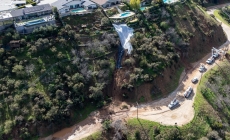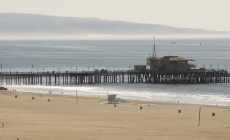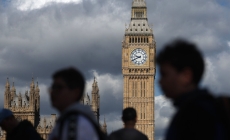-
The Best Places to Watch the Solar Eclipse Across the U.S. - March 19, 2024
-
A portion of Mulholland Drive, damaged by mudslides in winter storms, reopens - May 26, 2024
-
‘Maybe You Don’t Want to Win’ - May 26, 2024
-
Donald Trump Putting Law Enforcement in Danger: Attorney - May 26, 2024
-
Avoid the waters of these 5 L.A. County beaches this holiday weekend, public health officials say - May 26, 2024
-
Bawdy Comedy ‘Anora’ Wins Palme d’Or at Cannes Film Festival - May 26, 2024
-
Map Shows Heat Wave Zone Spread Into Five New States - May 26, 2024
-
Azusa police arrest suspected slingshot-wielding vandal - May 25, 2024
-
Donald Trump Hammers Judge Ahead of Jury Instructions - May 25, 2024
-
Sometimes U.S. and U.K. Politics Seem in Lock Step. Not This Year. - May 25, 2024
The Best Places to Watch the Solar Eclipse Across the U.S.
Dallas, Texas, and Cleveland, Ohio, are among the best locations to be able to watch the upcoming solar eclipse, according to calculations by NASA.
A total solar eclipse—when the sun is completely shrouded by the moon—is set to occur on April 8, passing from northern Mexico across the east and into New England. It will be visible across 13 U.S. states, as well as small portions of Tennessee and Michigan.
“You definitely want to be looking at the sky on April 8 because if you miss the solar eclipse this year, you have to wait two decades until the next chance to see a total solar eclipse from the contiguous United States,” Brian Lada, an astronomy expert at meteorology firm AccuWeather, previously told Newsweek.
With the spectacle expected to draw crowds across the nation to areas in the eclipse’s path, officials are already voicing concern about stretched public safety resources, while some schools plan to close for the day, citing student safety.

Space Frontiers/Hulton Archive/Getty/NASA
At least four states on the eclipse’s trajectory have urged residents to stock up on groceries and gas ahead of its occurrence, as traffic is expected to overwhelm local roads.
According to NASA, the best places and times to see the eclipse reach its totality are:
- Dallas, Texas: total eclipse is due to begin at 1:40 p.m. CT, reaching its maximum at 1:42 p.m. and ending at 1:44 p.m.
- Idabel, Oklahoma: total eclipse is due to begin at 1:45 p.m. CT, reaching its maximum at 1:47 p.m. and ending at 1:49 p.m.
- Little Rock, Arkansas: total eclipse is due to begin at 1:51 p.m. CT, reaching its maximum at 1:52 p.m. and ending at 1:54 p.m.
- Poplar Bluff, Missouri: total eclipse is due to begin at 1:56 p.m. CT, reaching its maximum in the same minute and ending at 2 p.m.
- Paducah, Kentucky: total eclipse is due to begin at 2 p.m. CT, reaching its maximum at 2:01 p.m. and ending at 2:02 p.m.
- Carbondale, Illinois: total eclipse is due to begin at 1:59 p.m. CT, reaching its maximum at 2:01 p.m. and ending at 2:03 p.m.
- Evansville, Indiana: total eclipse is due to begin at 2:02 p.m. CT, reaching its maximum at 2:04 p.m. and ending at 2:05 p.m.
- Cleveland, Ohio: total eclipse is due to begin at 3:13 p.m. ET, reaching its maximum at 3:15 p.m. and ending at 3:17 p.m.
- Erie, Pennsylvania: total eclipse is due to begin at 3:16 p.m. ET, reaching its maximum at 3:18 p.m. and ending at 3:20 p.m.
- Buffalo, New York: total eclipse is due to begin at 3:18 p.m. ET, reaching its maximum at 3:20 p.m. and ending at 3:22 p.m.
- Burlington, Vermont: total eclipse is due to begin at 3:26 p.m. ET, reaching its maximum at 3:27 p.m. and ending at 3:29 p.m.
- Lancaster, New Hampshire: total eclipse is due to begin at 3:27 p.m. ET, reaching its maximum at 3:29 p.m. and ending at 3:30 p.m.
- Caribou, Maine: total eclipse is due to begin at 3:32 p.m. ET, reaching its maximum at 3:33 p.m. and ending at 3:34 p.m.
While the total eclipse will only last for a few minutes in different viewing spots, partial eclipse activity will be visible for around an hour and a half in areas along its trajectory.
Officials have warned against looking directly at the sun, light from which can cause permanent damage to the eyes.
The National Park Service notes that the only way to safely view an eclipse is through filters such as eclipse glasses, or during a total eclipse.
“It is never safe to look at the sun without solar filters during any other phases of the eclipse, or if you are viewing a partial or annular eclipse,” it says.
Uncommon Knowledge
Newsweek is committed to challenging conventional wisdom and finding connections in the search for common ground.
Newsweek is committed to challenging conventional wisdom and finding connections in the search for common ground.
Source link































